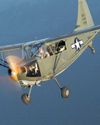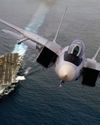Wichita Wonder
Flight Journal
|March - April 2025
Cessna’s I-50 proves to be astonishingly necessary for RCAF trainees

Before Pearl Harbor, nations at war desperately needed more twin-engine pilots. North of the U.S. border, the British Commonwealth Air Training Plan's armada of Airspeed Oxfords and Avro Ansons could not meet demands. Cessna's contribution not only saved the Allies, but rescued an American manufacturer from near collapse.
Roof shingles and lightning rods thudded into prairie snow as a yellow airplane slammed against a barn, west of Winnipeg. While tangs of dribbling 80/87 gasoline wafted outward, three men tumbled from the crumpled steel tube and shredded wings. The misadventure on April 16, 1944, which included a 500-foot trail of debris and a missing left wing of Royal Canadian Air Force (RCAF) Cessna Crane 7928, was not the first since the creation of the British Commonwealth Air Training Plan (BCATP) in 1939.
 This advertisement for the Cessna Aircraft Company Cessna T50 twin highlights the aircraft's versatility.
This advertisement for the Cessna Aircraft Company Cessna T50 twin highlights the aircraft's versatility.Dozens of the 245-hp Jacobs L-4 MBpowered Cranes had been bent or burned in rigorous efforts to prepare aircrew for battling the Axis hordes. As World War II progressed, Wichita's Cessna salesmen pushed their innovative Model T-50 to supplement training aircraft in sub-Arctic snows and blistering summer suns. Allied bomber offensives and complex twin-engine intruders demanded wing-wearing airmen ordained from diminutive single-engine airplanes. Few winged knights of hope en route to the heavies had felt fistfuls of Bakelite-knobbed throttles or sensed the ratcheting clicks of electric landing gears and fabric-covered flaps tremoring into fur-lined boots.
Denne historien er fra March - April 2025-utgaven av Flight Journal.
Abonner på Magzter GOLD for å få tilgang til tusenvis av kuraterte premiumhistorier og over 9000 magasiner og aviser.
Allerede abonnent? Logg på
FLERE HISTORIER FRA Flight Journal

Flight Journal
ELLIPTICAL ELEGANCE
Flying and evaluating the Seafire Mark III
4 mins
November - December 2025

Flight Journal
IRON DOG
Fighting the Pacific and the P-39 at the same time
14 mins
November - December 2025

Flight Journal
Fighter Pilots: A Warrior Clan
TAKE A HARD LOOK at the two young men in these photos. Do they look as if they were bent on killing one another? On the left we have a young, unknown enlisted Japanese pilot standing in front of a Nakajima Ki-27 \"Nate,\" one of Japan's earliest monoplanes that led to the much vaunted Zero.
3 mins
November - December 2025

Flight Journal
KEN WALSH THE FIRST CORSAIR ACE
Medal of Honor pilot's combat adventures
12 mins
November - December 2025

Flight Journal
Big Chief's Little Chief
Thunderbolt action with the Wolf Pack
11 mins
November - December 2025

Flight Journal
ENEMY PILOTS SPEAK Voices from the other side
All too often American students of air warfare forget that enemy aircraftwhether Messerschmitts or MiGs-were flown by human beings with the same motivations and traits as Allied airmen. More often than not, the only difference between friend and foe was the paint on the airplane and where they landed. Therefore, we've assembled a variety of accounts from WW II Axis fighter pilots, men who were more than simply targets.
11 mins
November - December 2025

Flight Journal
FLYING THE FW 190
A legend gets checked out in the Butcher Bird
15 mins
November - December 2025

Flight Journal
DOUBLE-THEATER ACE
The fearless missions of legendary fighter pilot Col. John D. Landers
12 mins
November - December 2025

Flight Journal
WARBUG IN THE PACIFIC
Surviving combat in a Stinson OY-1/L-5
10 mins
September - October 2025

Flight Journal
WINGS OF THE FLEET
Celebrating the U.S. Navy's 250-year legacy
9 mins
September - October 2025
Listen
Translate
Change font size

